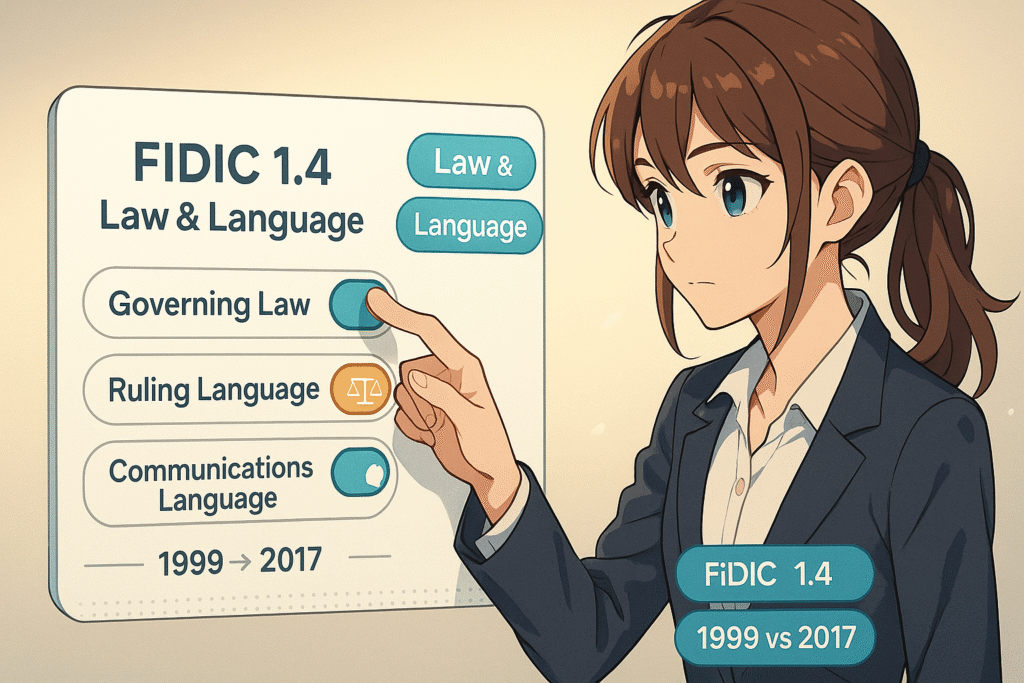Let’s decode what Sub-Clause 1.4 actually does and why it quietly governs so much of the contract’s day-to-day life. Spoiler: it decides three fundamentals—governing law, ruling language, and language for communications—and other clauses lean on these choices heavily.
1️⃣ Purpose of Sub-Clause 1.4
What it sets:
- Governing law of the Contract (inserted in the Appendix/Contract Data).
- Ruling language (the language of contractual interpretation and, under 2017, the language of arbitration).
- Language for communications (the operating language for meetings, notices, reports, Contractor’s Documents, etc.).
Both Books require these to be filled in the tender/Contract Data. The 1999 Appendix to Tender expressly asks you to state Governing Law, Ruling language, and Language for communications under 1.4; you can see the same three 1.4 entries in the 2017 Contract Data
Why it matters:
- The ruling language under 2017 is the language of arbitration.
- The language for communications controls the language of DAAB activities, Engineer/Contractor day-to-day, and even who must be “fluent” on the team】; the same idea appears in 1999 (e.g., Engineer’s assistants and Contractor’s Rep must be fluent in the 1.4 language)
Implications/Risk:
- Leave these blank and you risk fights over which law applies, which language prevails, and which language must be used for notices, submissions, and hearings.
2️⃣ Clause Breakdown of Sub-Clause 1.4
1999 (Plant & Design-Build)
- You must state in the Appendix to Tender: Governing Law, Ruling language, Language for communications
- Many operational duties explicitly point back to 1.4 (e.g., Engineer’s assistants’ fluency; Contractor’s Documents written in that language).
2017 (Plant & Design-Build)
- Contract Data again carries the three 1.4 entries (law, ruling language, communications language)
- Arbitration must be held in the ruling language
- DAAB (Rules) uses the language for communications defined in 1.4 for meetings, reports and hearings
- Fluency requirements for key people (Contractor’s Rep, superintendence) again point to 1.4
Close reading tip: In practice, 2017 separates ruling language (interpretation + arbitration) from language for communications (daily operations) more explicitly via cross-references, so the practical effect is clearer.
3️⃣ Key Interpretations & Practical Implications
- Two-language model:
- Ruling language = the language that prevails in case of inconsistency and is used in arbitration (explicit in 2017)
- Language for communications = the working language (DAAB proceedings, meetings, reports, site communications)
- Who must be fluent?
Contractors’ Representatives and personnel tied to Engineer/Contractor communications must be fluent in the 1.4 communications language (both editions) - Documents’ language:
1999 requires Contractor’s Documents to be written in the 1.4 communications language; 2017 mirrors the same logic across procedures (DAAB/Engineer/Rep references)
Why 2017’s emphasis?
FIDIC 2017 tightened cross-references so there’s less doubt about which language governs arbitration and which language you must operate in day-to-day. That reduces procedural skirmishes.
4️⃣ Cross-References that “lean” on 1.4 (illustrative)
- DAAB language = the 1.4 communications language
- Arbitration language = the 1.4 ruling language
- Fluency requirements for Contractor’s Rep/assistants/superintendence (both editions) point back to 1.4
- Contractor’s Documents (1999) in the 1.4 communications language
5️⃣ “What-If” Scenarios 🧪
A. “We forgot to fill 1.4!”
- Risk: Disputes over which law governs; tussles over which language controls notices, Engineer’s instructions, DAAB, and arbitration.
- Fix: Issue a Variation or PC amendment to populate 1.4 fields immediately (law, ruling language, communications language). Use 2017’s cross-refs as your guide for clarity
B. Bilingual project, two working languages
- Keep one ruling language (for interpretation/arbitration) to avoid split-brain awards
- Allow translations for operations, but specify the prevailing version (usually the ruling language).
- Allocate translation/interpretation logistics and costs in Particular Conditions; DAAB/Engineer/Rep fluency still anchored to 1.4
C. International arbitration planned
- Choose a neutral governing law if appropriate and a ruling language aligned with tribunal/seat expectations
- Keep the communications language realistic for site personnel (fluency demands in both Books)
6️⃣ Suggestions for Clarity & PCs ✍️
Consider adding these into your Particular Conditions:
- Explicit Prevailing Text Rule
“If translations are produced, the ruling language version prevails for interpretation and dispute resolution. Translations are for convenience only.”
(Tracks the 2017 intent that arbitration uses the ruling language)
- Interpreter/Translation Logistics
“Each Party arranges and bears the cost of interpreters for its own personnel; costs of official hearing interpreters (DAAB/arbitration) are shared equally unless otherwise ordered.”
(Aligns with DAAB using the 1.4 communications language)
- Document Language Discipline
“All Notices under 1.3 and Contractor’s Documents shall be in the language for communications; if provided in another language, a certified translation in the communications language shall accompany the submission.”
(1999 already points Contractor’s Documents to 1.4 language)
- Fluency Requirements
“Contractor’s Representative and Key Personnel must be fluent in the language for communications; otherwise the Contractor shall provide competent interpreters at its cost.”
(Consistent with both editions’ cross-refs)
7️⃣ Final Takeaways 🔎
- Fill all three fields under 1.4 (law, ruling language, communications language) at tender stage—don’t rely on guesswork.
- 2017 clarifies use-cases: ruling language = arbitration; communications language = DAAB + everyday contract administration
- Operational fluency and document language obligations across the contract point back to 1.4 (both editions)
🧩 Quick Visual: “Three Switches” You Must Set (for your article)
- Governing Law → decides which legal system answers contract questions
- Ruling Language → controls interpretation & arbitration language
- Language for Communications → runs daily operations/DAAB/Engineer workflows

